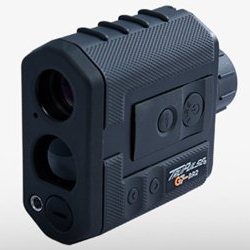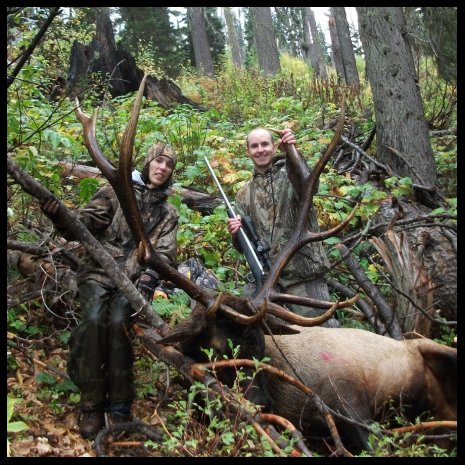Long Range Hunting

Long range rifle shooting (and hunting) is gaining popularity fast. The tools and information needed to be accurate at longer distances are becoming readily available to the general public. Long range hunting requires accurate equipment, lots of practice, tuning your skills, educating yourself on your equipment, and maintaining good hunting practices and ethics. Long range shooting performance is a science, and one could go on and on in any article related to this.
What is long range? This is often best defined in the eye of the beholder. I can remember when 300 yards was talked about as the above-norm distance. These days, you hear of kills in excess of 1000 yards! How far is too far? This is subjective, but could probably be best answered with the question, “What kind of group can you shoot at 800 or 1200 yards?” Or, “What kind of group can you shoot at 100 yards?”
There are several people who consider themselves long range shooters, most of whom are effective at distances less than 1000 yards. The effective equipment for this range of shooting can differ from the extreme range shooter. It has always been my opinion that ballistic turrets and ballistic reticles excelled and suffered from the same thing – they are fast and user friendly, but at some distance they will hold you back in terms of effectiveness. For the most part, I considered this range to be 600 yards or so given the requirements of my accuracy. The reason for this is simply the lack of ability to factor in the atmospheric conditions of temperature, pressure, elevation, etc. To be effective past this distance, I need a ballistic program, weather station, and a dial-up scope. I cannot explain how important a ballistics program is for long-range shooting. It will reveal (in most situations) how inaccurate you will be if you shoot long range without compensating for atmospheric conditions.
 This past fall, I had the chance to use the Gunwerks G7 BR2 rangefinder on several hunts and I am very impressed with this tool. The G7 BR2 is able to utilize measurements of line of sight range, incline angle, and air density to make a complete ballistic calculation of the “Shoot To” range for your custom Ballistic Turret or reticle. “Just range it and dial it” has never been so simple or precise. The G7 rangefinder accepts data for 6 different loads, which means you can program it for several individual rifles, allowing you to choose your weapon and head to the field, ready for any long range opportunity. It will calculate and give you a dial up solution out to 1400 yards, which is farther than most of us will/should attempt.
This past fall, I had the chance to use the Gunwerks G7 BR2 rangefinder on several hunts and I am very impressed with this tool. The G7 BR2 is able to utilize measurements of line of sight range, incline angle, and air density to make a complete ballistic calculation of the “Shoot To” range for your custom Ballistic Turret or reticle. “Just range it and dial it” has never been so simple or precise. The G7 rangefinder accepts data for 6 different loads, which means you can program it for several individual rifles, allowing you to choose your weapon and head to the field, ready for any long range opportunity. It will calculate and give you a dial up solution out to 1400 yards, which is farther than most of us will/should attempt.
Down-range bullet performance
When hunting, it is important to also consider velocity and foot-pounds of energy at longer distances. Shooting big game animals at long range requires the impact velocity/energy of the projectile be sufficient enough to allow for proper bullet expansion and a good clean kill. I have read a lot of different articles on this and there are various opinions, but I would suggest that good, killing performance occurs if the impact velocity is at or above 2,500 fps, while retaining at least 1,500 foot-pounds of energy on medium sized game animals, and 2,300 foot-pounds of energy on the larger animals. A high velocity and ballistic coefficient is important, and the type of bullet you use will also determine how well it performs, especially at lower velocities. A general rule of thumb is softer bullets, or hollow point bullets, perform best at lower velocities, but do not perform as well at closer ranges or higher velocities. Be sure to do your research and determine what works best for what you will be using it for.
Ethics
Now let’s talk about ethics. No matter what I choose to hunt with, ethics is a huge factor. I want to do it right the first time, every time. What is the maximum range you should shoot? My maximum range is 800-900 yards depending on the weather conditions. I shoot a 300 Win Mag capable of sub-½ inch groups at 100 yards. This accuracy should translate to a 4-5” group at 800 yards, but with atmospheric conditions having an exponential effect on bullet flight, farther shots make it more difficult to pull off. In addition to killing power, high velocity at the longer ranges gives you a flatter trajectory for less margin of error if your range calculations are not exact. This can occur when your rangefinder ranges a tree or rock 50 yards in front of or behind the animal you are actually trying to range.
 Personally, my rule of thumb is if I can’t shoot a 5” group (3 shots) at any distance, I simply won’t shoot. We owe that to the critters we are shooting at. I will give my stalking skills a chance before I take less-than-ideal shots. I would much rather eat tag soup than wound an animal, and if I make a mistake and mess up a shot, I will punch my tag and be done. These standards that I have set for my personal rifle and bullet performance have served me well for several years.
Personally, my rule of thumb is if I can’t shoot a 5” group (3 shots) at any distance, I simply won’t shoot. We owe that to the critters we are shooting at. I will give my stalking skills a chance before I take less-than-ideal shots. I would much rather eat tag soup than wound an animal, and if I make a mistake and mess up a shot, I will punch my tag and be done. These standards that I have set for my personal rifle and bullet performance have served me well for several years.
Lastly, check your gear and shoot your weapon to be sure of performance just prior to any hunt. Things happen in the field, and even the best of equipment can be subject to abuse and accidents. I can personally attest to this! Please take the time to practice and study up on the science of bullet flight and energy. The more you know about factors that affect long range performance, the better long range hunter you will become.
